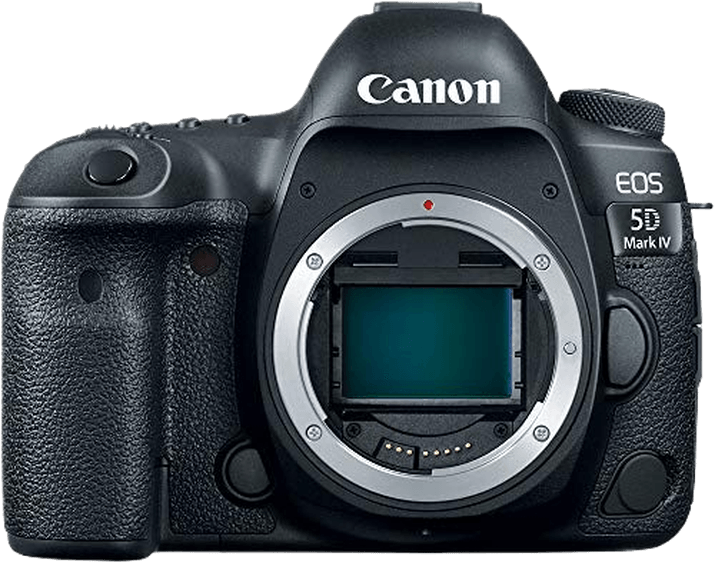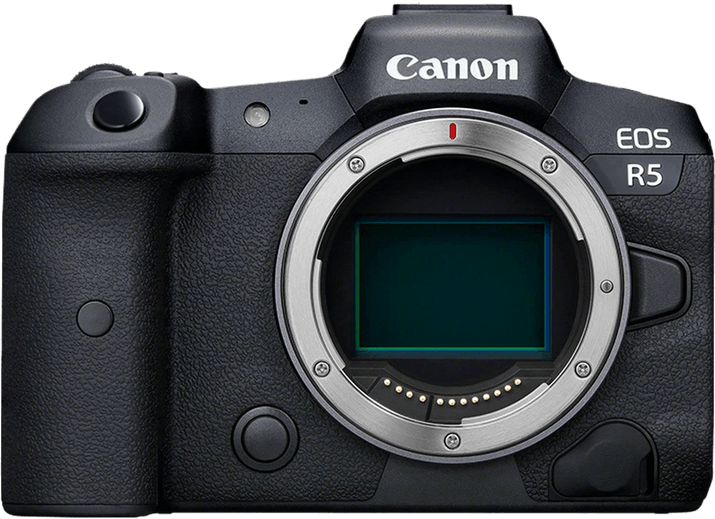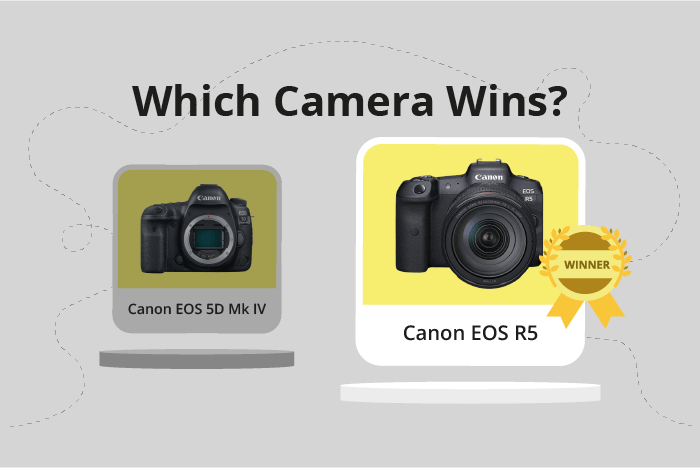Canon EOS 5D Mark IV vs EOS R5 Comparison
Canon EOS 5D Mark IV

Canon EOS R5

The Canon EOS R5 outperforms the Canon EOS 5D Mark IV with a score of 86/100 compared to 75/100. Both cameras share similarities, such as being part of the Canon EOS family and having a full-frame sensor. However, the R5, a mirrorless camera released in 2020, has several advantages over the 5D Mark IV, a DSLR from 2016.
The R5 is lighter and more compact, weighing 680g and measuring 138 x 98 x 88mm, while the 5D Mark IV weighs 890g and measures 151 x 116 x 76mm. This makes the R5 easier to handle and carry. On the other hand, the 5D Mark IV is more affordable, with a launch price of $3500 compared to the R5’s $4499.
Considering the higher score, lighter weight, and compact size, the Canon EOS R5 is the superior choice. However, for those seeking a more budget-friendly option, the Canon EOS 5D Mark IV remains a reliable alternative.
Canon EOS 5D Mark IV vs EOS R5 Overview and Optics
The Canon EOS R5 outperforms the Canon EOS 5D Mark IV in optics, scoring 88/100 compared to the 5D Mark IV’s 76/100. Both cameras share several specifications, including a CMOS sensor, full frame sensor size, and the same manufacturer, Canon. However, there are key differences that contribute to the R5’s superior optics performance.
The R5 has a higher megapixel count at 45, compared to the 5D Mark IV’s 30.4, resulting in more detailed and higher resolution images. The R5 also features a faster shooting speed of 20, double that of the 5D Mark IV’s 7, allowing for better capture of fast-moving subjects. The R5’s Digic X processor is more advanced than the 5D Mark IV’s Digic 6+, providing faster processing and improved image quality. Furthermore, the R5’s DXOMARK sensor score is 95, four points higher than the 5D Mark IV’s 91, indicating better overall sensor performance.
The Canon EOS R5 has the advantage of image stabilization, which the 5D Mark IV lacks, reducing the risk of blurry images due to camera shake. Additionally, the R5 uses the Canon RF lens mount, which offers compatibility with a newer range of lenses designed specifically for mirrorless cameras.
The 5D Mark IV, on the other hand, uses the Canon EF lens mount, providing compatibility with a wider variety of existing Canon lenses. This may be beneficial for photographers who already own a collection of EF lenses.
Considering the higher megapixel count, faster shooting speed, better processor, higher DXOMARK sensor score, image stabilization, and newer lens mount, the Canon EOS R5 is the clear winner in optics performance. However, the Canon EOS 5D Mark IV may still be a suitable choice for those who prioritize lens compatibility and have an existing collection of EF lenses.
Canon EOS 5D Mark IV vs EOS R5 Video Performance
The Canon EOS R5 outperforms the Canon EOS 5D Mark IV in video capabilities with a score of 100/100 compared to the 5D Mark IV’s 91/100. Both cameras share common features, such as a maximum video frame rate of 120fps and built-in time-lapse functionality. However, the EOS R5 surpasses the 5D Mark IV in several aspects, making it the superior choice for videographers.
The most significant advantage of the EOS R5 over the 5D Mark IV is its maximum video resolution. The R5 records 8K video with dimensions of 8192 x 4320, while the 5D Mark IV’s maximum resolution is 4K at 4096 x 2160. This difference means that the R5 can capture more detail, resulting in sharper and more visually stunning video footage.
In terms of areas where the 5D Mark IV excels, it is challenging to pinpoint specific advantages over the R5 in video capabilities. Both cameras have the same maximum frame rate and time-lapse features, making the R5 the clear winner in this comparison.
To conclude, the Canon EOS R5 is the superior camera for video recording due to its higher video score and 8K resolution. The shared features between the two cameras, such as the 120fps frame rate and time-lapse functionality, do not provide the 5D Mark IV with any distinct advantages in this comparison. Therefore, for videographers seeking the best performance and video quality, the Canon EOS R5 is the ideal choice.
Canon EOS 5D Mark IV vs EOS R5 Features and Benefits
The Canon EOS R5 outperforms the Canon EOS 5D Mark IV in features, scoring 87/100 compared to the 5D Mark IV’s 74/100. Both cameras share a 3.2-inch screen size, touchscreen capability, and Wi-Fi connectivity. Despite these similarities, there are key differences that set the R5 apart.
The R5 excels with its higher screen resolution of 2,100,000 dots, compared to the 5D Mark IV’s 1,620,000 dots. This provides a sharper and more detailed display for users. Additionally, the R5 has a flip screen, offering greater flexibility and ease when composing shots from various angles. The inclusion of Bluetooth connectivity in the R5 allows for seamless pairing with compatible devices, enhancing the user experience.
On the other hand, the 5D Mark IV has GPS functionality, which the R5 lacks. This feature enables geotagging of photos, useful for photographers documenting their travels or needing precise location information. However, this advantage does not outweigh the benefits provided by the R5’s superior features.
In comparing the two cameras, the Canon EOS R5 emerges as the better option due to its higher screen resolution, flip screen, and Bluetooth connectivity. While the Canon EOS 5D Mark IV offers GPS functionality, it falls short in other areas, making the R5 a more versatile and user-friendly choice for photographers.
Canon EOS 5D Mark IV vs EOS R5 Storage and Battery
The Canon EOS 5D Mark IV wins in the storage and battery category with a score of 71/100, compared to the Canon EOS R5’s score of 68/100. Both cameras share similarities, such as having two memory card slots and accepting SD/SDHC/SDXC cards. However, the 5D Mark IV is compatible with UHS-I, while the R5 is compatible with the faster UHS-II and also supports CFexpress cards.
The 5D Mark IV outperforms the R5 in terms of battery life, offering 900 shots per charge compared to the R5’s 320 shots. Both cameras use a similar battery type, with the 5D Mark IV using the LP-E6N and the R5 using the LP-E6NH.
Despite its lower score, the EOS R5 has the advantage of USB charging, which the 5D Mark IV lacks. This feature allows for more convenient charging options, especially while traveling or on location.
To sum up, the Canon EOS 5D Mark IV offers better battery life and a slightly higher storage and battery score. However, the Canon EOS R5 provides faster memory card compatibility and the convenience of USB charging.
Alternatives to the Canon EOS 5D Mark IV and EOS R5
Are you still undecided about which camera is right for you? Have a look at these popular comparisons that feature the Canon EOS 5D Mark IV or the Canon EOS R5:

